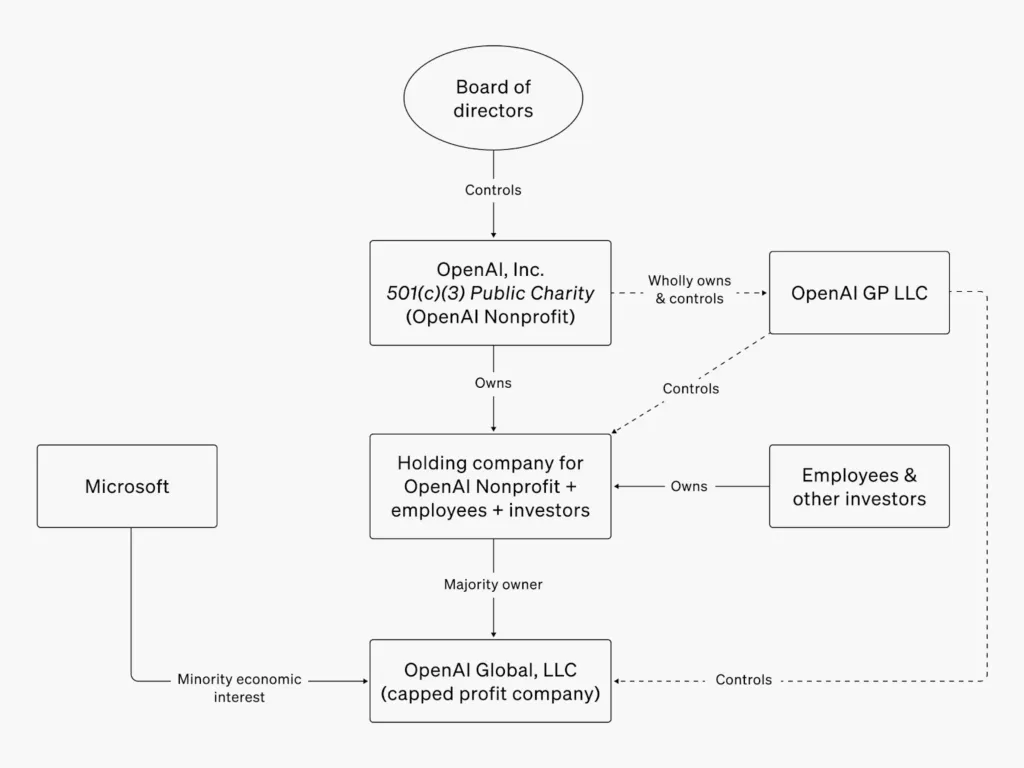|
Getting your Trinity Audio player ready...
|
OpenAI, the company behind ChatGPT, is undergoing significant changes. The biggest shift is that the company, currently a non-profit, will transition into a for-profit benefit corporation by 2025. A for-profit benefit corporation, often called a B corp, aims to positively impact society and the environment while generating profit. This move coincides with OpenAI looking to raise $6.5 billion at a staggering $150 billion valuation. Transitioning to a for-profit structure will likely help the company raise its capital, especially compared to its current convoluted setup.

The company may be making this move to streamline operations and attract more investors. Under the current structure, raising significant capital can be complicated due to the non-profit status intertwined with a for-profit subsidiary. By becoming a for-profit benefit corporation, OpenAI can more directly pursue its financial goals without having to answer to a non-profit board adamant about the company’s mission and impact above all else.
Shortly before the change of entity was announced, another change occurred at OpenAI as its CTO and former interim CEO, Mira Murati, announced that she would be leaving the company. She and CEO Sam Altman acknowledged that her departure was abrupt and unexpected. However, Altman insists that the departure is not linked to the company’s restructuring.
This isn’t the first time we’ve seen executives and key employees leave OpenAI. Previously, when another key figure departed, they claimed that at the company, safety had “taken a back seat to shiny products.” By becoming a for-profit company, OpenAI and its shareholders may be less inclined to prioritize the safety aspects that were core to its non-profit ethos and might instead focus more on steering the company—which currently loses far more money than it makes—into profitable territory.
FTC launches ‘Operation AI Comply’ to crack down on deceptive AI businesses
The Federal Trade Commission (FTC) is cracking down on businesses capitalizing on the hype of AI to launch deceptive or misleading businesses in what it calls “Operation AI Comply.” The agency has already taken action against five companies, each using AI as a buzzword to lure customers in while failing to deliver on their promises. These companies made claims that never materialized or provided no evidence to back up their assertions, typically revolving around how their AI product or service would generate significant revenue for individuals or small businesses thanks to their supposed novel artificial intelligence capabilities.
“Using AI tools to trick, mislead, or defraud people is illegal,” said FTC Chair Lina Khan. “The FTC’s enforcement actions make clear that there is no AI exemption from the laws on the books. By cracking down on unfair or deceptive practices in these markets, the FTC is ensuring that honest businesses and innovators can get a fair shot, and consumers are being protected.”
Whenever innovation takes place, and there’s an opportunity to make money, criminals and fraudsters are attracted to it. Because of AI’s popularity over the last few years, “artificial intelligence” has become a buzzword, often giving those who use it or attach it to their business a more favorable outlook. Unfortunately, some individuals, like the five companies the FTC has taken action against, exploit consumers by using these buzzwords to lure them in but ultimately failing to deliver on their initial promises–this is something we’ve seen time and time again in the blockchain and digital asset world as well.
To combat this, law enforcement agencies must rigorously enforce laws and punish those who defraud consumers. One way they do this is by making an example out of early violators, just as the FTC did with the five companies it pressed charges against and as the SEC did with many of the first companies to conduct Initial Coin Offerings (ICOs). These actions serve as a deterrent to others who might consider engaging in deceptive practices, with the goal of protecting consumers and keeping emerging markets stable.
Meta AI introduces new features: Voice-to-voice, computer vision, and more
Meta (NASDAQ: META) has announced that several new features are either live or going live in Meta AI, which is essentially Meta’s version of ChatGPT operating within Messenger, Facebook, WhatsApp, and Instagram. Among the new features are voice-to-voice capabilities, allowing users to use speech as input and receive spoken output. There’s also computer vision, where Meta AI can analyze images, identify different items within those images, and even edit them. Meta AI will also have translation features geared toward content creators.
In addition, Meta AI will support video on the Ray-Ban Meta smart glasses. Users can film their surroundings, and Meta AI can analyze and identify different objects in their environment in real time.
Without a doubt, these new features will be helpful to users. But my first thought when I heard about them was, “Is Meta too late?” OpenAI’s ChatGPT has been able to do nearly all these things for roughly a year. Anyone who truly needed these AI features probably had that need satisfied by using GPT or another AI model specific to their tasks. I don’t think that Meta entering the AI race this late will move the needle enough for users to switch from their current AI model of choice over to Meta.
However, one thing that Meta does have going for it is distribution. Between Facebook, Instagram, and WhatsApp, Meta has billions of users worldwide. Integrating Meta AI into each of these platforms seamlessly onboards that multi-billion user base into Meta AI. This massive built-in audience could give Meta a significant advantage in adoption rates, even if their AI offerings are similar to, or worse than, what competitors have provided for some time.
In order for artificial intelligence (AI) to work right within the law and thrive in the face of growing challenges, it needs to integrate an enterprise blockchain system that ensures data input quality and ownership—allowing it to keep data safe while also guaranteeing the immutability of data. Check out CoinGeek’s coverage on this emerging tech to learn more why Enterprise blockchain will be the backbone of AI.
Watch: Demonstrating the potential of blockchain’s fusion with AI

 09-07-2025
09-07-2025 





